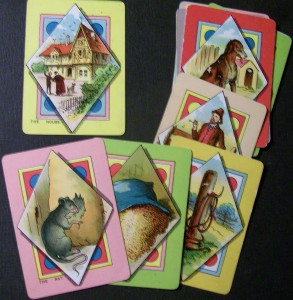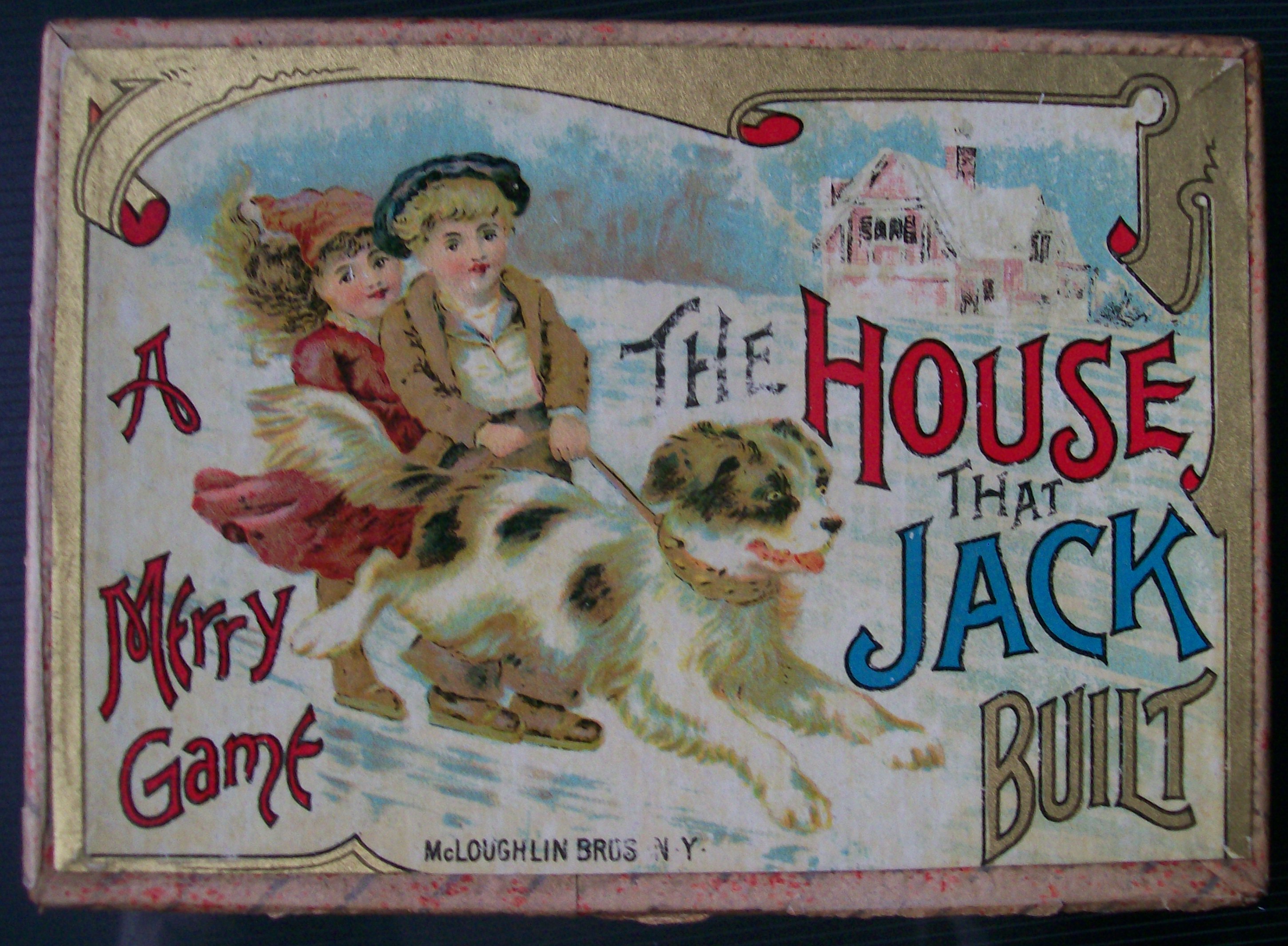 The 1887 game, The House that Jack Built, illustrates just another example of why McLoughlin Bros. games are so collectible. The wonderful artwork found within McLoughlin games is admired and sought after by many collectors. On the colorful game box of The House that Jack Built is a depiction of two small children and a dog enjoying a snowy, winter day together. As can be noticed, the McLoughlin game adds a charming piece to be displayed in any game cabinet.
The 1887 game, The House that Jack Built, illustrates just another example of why McLoughlin Bros. games are so collectible. The wonderful artwork found within McLoughlin games is admired and sought after by many collectors. On the colorful game box of The House that Jack Built is a depiction of two small children and a dog enjoying a snowy, winter day together. As can be noticed, the McLoughlin game adds a charming piece to be displayed in any game cabinet.
The game comprises of 42 cards of equal appeal. There are twelve picture cards. One card illustrates Jack’s house, while the eleven others represent his most valued possessions. Then there are thirty object cards which have their items written in the card’s center.
At the start of the game, the House that Jack Built card is placed in the center of the table. All other cards are shuffled, and dealt one at a time, to players.
 Counters are required to play the game. Each player should be supplied with the same amount of fifteen. Interestingly, none are supplied in the game box. Players are told to use ‘buttons or beans’ and are informed by the instructions that these work better than any counters which could be supplied. These are similar instructions to the first Monopoly game by Charles Darrow. Players were informed to find any small household item to use as a game token. It is believed these instructions had many players choose a thimble, which in turn influenced the thimble to eventually be officially included as a Monopoly game piece by Parker Brothers.
Counters are required to play the game. Each player should be supplied with the same amount of fifteen. Interestingly, none are supplied in the game box. Players are told to use ‘buttons or beans’ and are informed by the instructions that these work better than any counters which could be supplied. These are similar instructions to the first Monopoly game by Charles Darrow. Players were informed to find any small household item to use as a game token. It is believed these instructions had many players choose a thimble, which in turn influenced the thimble to eventually be officially included as a Monopoly game piece by Parker Brothers.
The dealer for The House that Jack Built game begins by reading a story. It speaks of the house that Jack built and the desire of a son to gather all of his father’s wonderful things which belonged to him. Questions are then asked by the dealer, to the players, in order to collect these ‘valued possessions’ for the house.
 The first question the dealer asks is “Can you bring me the Malt that lay in the house that Jack built?” If the player on the dealer’s left has the ‘Malt’ card, he places it on the House card and collects the player’s beginning counters. If he does not have the card, he plays an object card and pays a counter as penalty for not having the ‘valued possession.’
The first question the dealer asks is “Can you bring me the Malt that lay in the house that Jack built?” If the player on the dealer’s left has the ‘Malt’ card, he places it on the House card and collects the player’s beginning counters. If he does not have the card, he plays an object card and pays a counter as penalty for not having the ‘valued possession.’
Turns pass in this manner. The dealer asks for a ‘valued possession’. A player places the possession card on the house, if he can. If not, he pays a penalty and plays an object card. The player who places the asked for item, receives any counters which have been paid. At the start of each new question, one counter is placed by each player.
Other questions the dealer asks are as follows:
Can you bring the sack that held the malt?
Can you find the rope that tied the sack?
Can you catch me the rat that gnawed the rope?
Can you find the cat that killed the rat?
Can you bring me the dog that worried the cat?
Can you find the cow with the crumpled horn that tossed the dog?
Can bring the Maiden all forlorn that milked the cow?
Can you find the man all tattered and torn?
Can you find the Priest all shaven and shorn?
Can you find the cock that crowed in the morn to wake the Priest?
The game ends when all possessions of the house are collected. The player with the most counters at the end of the game, wins.
Like many of the past games, game play is simple. Entertainment was found by relaxing around the parlor table and enjoying each other’s company.

I have the 1887 the house that jack built card game in mint condition how much is it worth
Have a complete set of this 1887 card game let me know what is it worth?